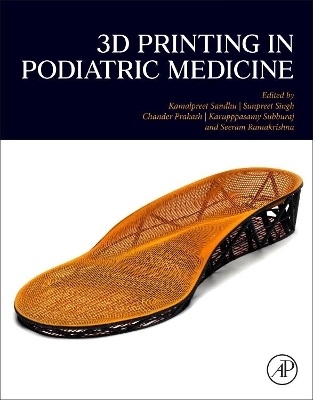
3D Printing in Podiatric Medicine
Academic Press Inc (Verlag)
978-0-323-91911-1 (ISBN)
This book supports new and emerging specializations and provides a comprehensive collection of technical notes, research designs, design methods and processes and case studies.
Kamalpreet Sandhu, MEng. is an Assistant Professor in the Product and Industrial Design Department at Lovely Professional University, Phagwara, Punjab. His primary focus is on design and development of footwear products and injury prevention. He has worked on projects in Podiatric Medicine at the Defence Institute of Physiology and Allied Sciences, DRDO, Delhi i.e., Designed and developed new kind of orthosis for social needs. This work resulted in the publication “Effect of Shod Walking on Plantar Pressure with Varying Insole. His areas of research are 3D printing, Ergonomics and Human Gait Analysis. He is also an Editor of Books, SPRINGER NATURE “Emerging Application of 3D printing during Covid19 pandemic, Sustainability for 3D Printing, Application of 3D printing in Biomedical Engineering and Food Printing: 3D printing in Food sector. He also acts as an Editorial Review board member for the “International Journal of Technology and Human Interaction (IJTHI) and the Advances in Science, Technology and Engineering Systems Journal (ASTESJ). He is working in collaboration with Prof. Karupppasamy Subburaj, Medical Engineering and Design (MED) laboratory, Singapore University of Technology and Design (SUTD). Sunpreet Singh is researcher in NUS Nanoscience & Nanotechnology Initiative (NUSNNI). He has received Ph.D in Mechanical Engineering from Guru Nanak Dev Engineering College, Ludhiana, India. He has contributed extensively in additive manufacturing literature with publications appearing in Journal of Manufacturing Processes, Composite Part: B, Rapid Prototyping Journal, Journal of Mechanical Science and Technology, Measurement, International Journal of Advance Manufacturing Technology, and Journal of Cleaner Production. He has authored more than 150+ research papers and book chapters. He is also editor of 3 books- "Current Trends in Bio-manufacturing", “3D Printing in Biomedical Engineering, and "Biomaterials in Orthopaedics and Bone Regeneration - Design and Synthesis". He is also guest editor of several journals- special issue of “Functional Materials and Advanced Manufacturing, Facta Universitatis, series: Mechanical Engineering (Scopus Indexed), Materials Science Forum (Scopus Indexed), and special issue on “Metrology in Materials and Advanced Manufacturing, Measurement and Control (SCI indexed), Materials, Sustainability (MDPI). Chander Prakash is Pro-Vice Chancellor, University Centre for Research and Development, Chandigarh University, Mohali, Punjab, 140413, India. His area of research is biomaterials, rapid prototyping & 3-D printing, advanced manufacturing, modelling, simulation, and optimization. He has more than 11 years of teaching experience and 6 years research experience. He has contributed extensively to the world in the Titanium and Magnesium based implant academic literature. Karupppasamy Subburaj, PhD. is an Assistant Professor and the lead for the Healthcare Engineering and Design track in the Engineering Product Development (EPD) Pillar at Singapore University of Technology and Design (SUTD) since 2014. He leads the Medical Engineering and Design (MED) laboratory, an interdisciplinary research group specializing in design and development of medical devices, medical imaging and image analysis methods, and computing tools for diagnosing, treating, and potentially preventing musculoskeletal disorders and disabilities. Recognizing that collaborative bridges between different disciplines are the key to advancement in research, he brings basic scientists, clinical researchers, design engineers, and physicians together to conduct clinically relevant research and translate it to patient care. He is also passionate about design education and teaching and received the SUTD Outstanding Education Award: Excellence in Teaching (2019) for his contributions. His research resulted in 4 patents, 2 books, 50 peer-reviewed technical articles in highly referred international journals, and 80 international conference articles and presentations. Subburaj received his doctorate (2019) from the Indian Institute of Technology Bombay and postdoctoral (2010-2014) research training in Musculoskeletal Quantitative Imaging Research laboratory in the Department of Radiology and Biomedical Imaging at the University of California San Francisco (UCSF). Seeram Ramakrishna is the Director of the Center for Nanofibres and Nanotechnology at the National University of Singapore (NUS), which is ranked among the top 20 universities in the world. He is regarded as the modern father of electrospinning. He is an elected Fellow of UK Royal Academy of Engineering (FREng); Singapore Academy of Engineering; Indian National Academy of Engineering; and ASEAN Academy of Engineering & Technology. He is an elected Fellow of the International Union of Societies of Biomaterials Science and Engineering (FBSE); Institution of Engineers Singapore; ISTE, India; Institution of Mechanical Engineers and Institute of Materials, Minerals & Mining, UK; and American Association of the Advancement of Science; ASM International; American Society for Mechanical Engineers; American Institute for Medical & Biological Engineering, USA. He is an editor of Elsevier journal Current Opinion in Biomedical Engineering.
1. Introduction to 3D printing in Biomechanics
2. Advancement in 3D printing material and its properties for Podiatric Medicine
3. 3D printed accessories for Podiatric Medicine
4. Amalgamation of Reverse Engineering, CAD/CAM and Artificial Intelligence with 3D printing in Podiatric Medicine
5. Clinical reports to evaluate the 3D printed
6. Designing of templates and guides for foot surgery
7. Ergonomics factors- Physical, Cognitive and organizational in Podiatric Medicine
8. Social and Commercial trends of 3D printed orthosis
9. Ongoing challenges and Future recommendations in Podiatric Medicine.
| Erscheinungsdatum | 02.11.2022 |
|---|---|
| Verlagsort | Oxford |
| Sprache | englisch |
| Maße | 152 x 229 mm |
| Gewicht | 450 g |
| Themenwelt | Medizin / Pharmazie ► Gesundheitsfachberufe ► Kosmetik / Podologie |
| Studium ► 1. Studienabschnitt (Vorklinik) ► Physiologie | |
| Technik | |
| ISBN-10 | 0-323-91911-1 / 0323919111 |
| ISBN-13 | 978-0-323-91911-1 / 9780323919111 |
| Zustand | Neuware |
| Haben Sie eine Frage zum Produkt? |
aus dem Bereich


